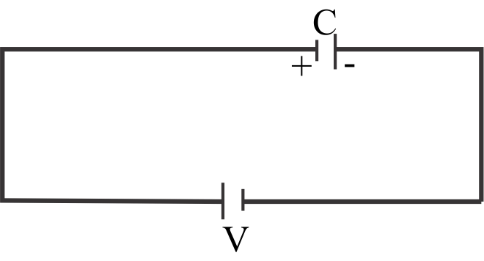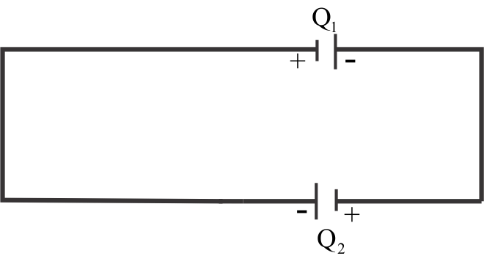Question
Question: A capacitor is charged by a battery. The battery is removed and another identical uncharged capacito...
A capacitor is charged by a battery. The battery is removed and another identical uncharged capacitor is connected in parallel. The total electrostatic energy of the resulting system:
(a) Increase by a factor of 2
(b) Increase by a factor of 4
(c) Decrease by a factor of 2
(d) Remains the same
Solution
Kirchhoff’s Voltage Law is that the second of his elementary laws we will use for circuit analysis. His voltage law states that for a closed-loop system series path the algebraically total of all the voltages around any closed-loop system in an exceeding circuit is adequate zero. This is often as a result of a circuit loop that could be a closed conducting path thus no energy is lost.
Complete step by step solution: Here in the question it is given that the capacitor is charged initially with the battery. For this, the diagram is shown below.


The total charge is equal to Q0;
Therefore from the figure, we can write,
⇒Q1+Q2=Q0
Now applying KVL,
And as we know in KVL for a closed-loop system series path the algebraically total of all the voltages around any closed-loop system in an exceeding circuit is adequate zero.
Therefore,
⇒CQ1=CQ2=0
On further solving the equation, we can write it as;
⇒Q1=Q2
And since Q1+Q2=Q0
Therefore
⇒Q1=Q2=2Q0
Since the initial electrostatic charge is,
⇒Ei=21CV2=2CQ02
Therefore, the final electrostatic charge will be
⇒Ef=21CV2+21CV2
Now putting the values which we have calculated initially in the above equation, we get
⇒2CQ12+2CQ22
On further solving,
⇒8CQ02+8CQ02
Adding both the terms, we get
⇒4CQ02
So now we will calculate the ratio of Efand Ei
We get,
EiEf=2CQ024CQ02
On solving this, we get
EiEf=21
Therefore, the total electrostatic energy of the resulting system decrease by a factor 2.
Note: The theory behind Kirchhoff’s second law is additionally called the law of conservation of voltage, and this is often notably helpful for us once managing series circuits, as series circuits conjointly act as voltage dividers and therefore the voltage divider circuit is a very important application of the many series circuits.
